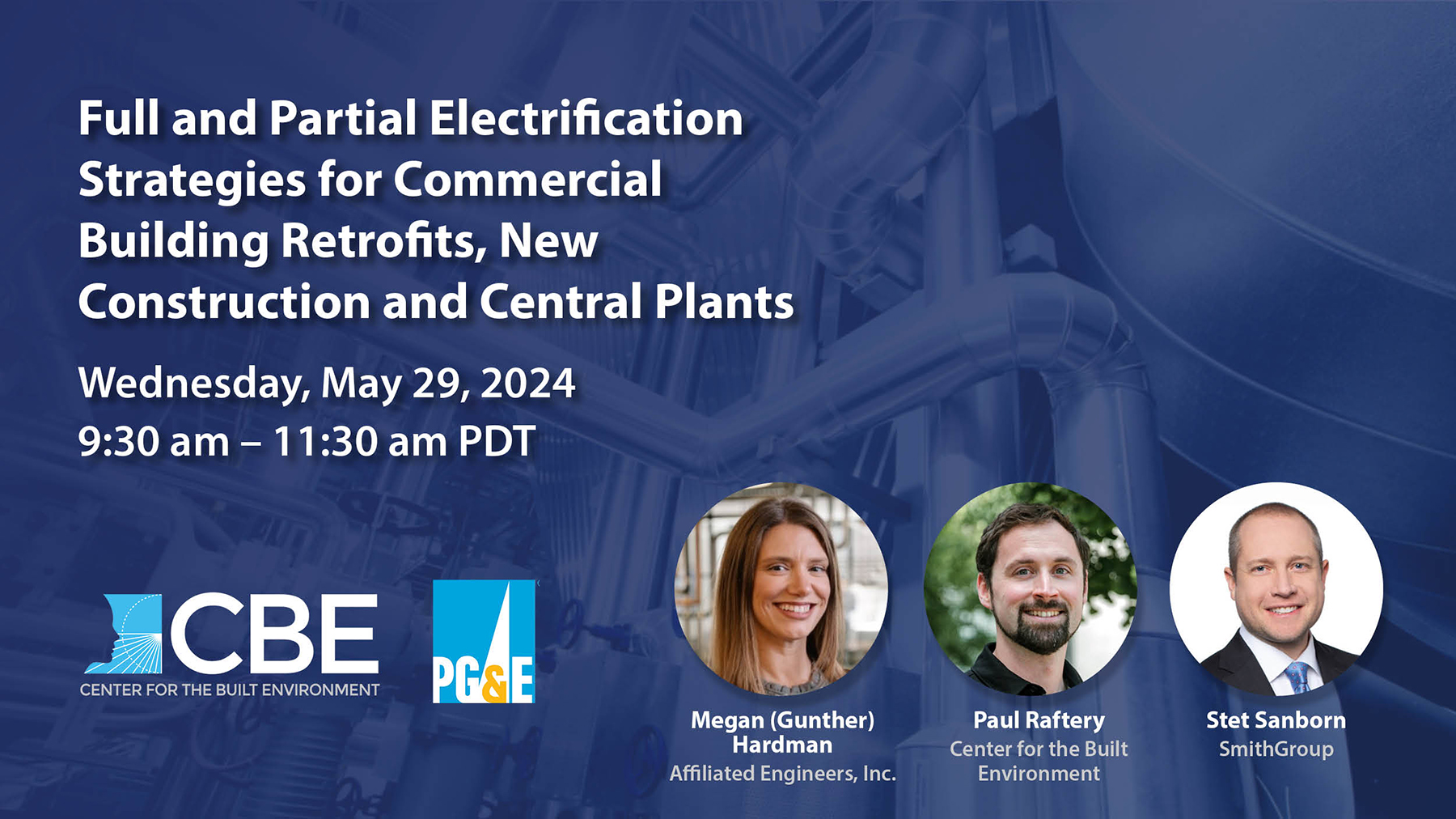
May 29, 2024 9:30 am - 11:30 am PDT
Building electrification through the use of heat pumps is gaining traction as an effective means to reducing emissions from building operations. However, barriers remain to 100% adoption of this technology, especially in existing buildings where cost, space or other constraints exist, requiring creative approaches to maximize emission reductions per dollar spent. In this webinar, experts from both professional practice and research demonstrated how they are creating deep emission reductions through right-sizing heat pumps, better HVAC design, integration of thermal storage and hybrid solutions. The session covered diverse project types including existing buildings, new construction and district plants, and also how such approaches may extend the life of equipment.
In retrofits for example, replacing a boiler with a similarly sized heat pump may often be impractical and/or costly. This course will present new research that analyzed HVAC data from 200 commercial buildings revealing that standard design practices are greatly over estimating peak loads, and how this knowledge informed case studies that reduced emissions by as much as 70% through boiler retrofits, improved control strategies, and/or hybrid systems. The class also introduced methods for screening to identify candidate buildings for retrofit.
For new construction, this webinar presented a case study that integrated thermal storage to fully electrify a higher education building, downsizing the heat pump while meeting a stringent design-build budget. This approach also offers improved flexibility and building whole-life responsiveness to meet the changing demands and emission profiles of the future grid. Finally, the course included three case studies for central plant electrification projects at university campuses in California with promising emission reductions.
Speakers and Presentations
-

Megan Hardman, PE
Principal at Affiliated Engineers, Inc.
Presentation: District Scale Electrification
A vital and dynamic firm leader, Megan Hardman was instrumental in establishing the AEI San Francisco Building Performance Practice and extending this core service to the West Coast. As a principal and department facilitator, Megan collaborates and inspires passion within her team to guide and assist clients in achieving holistic, tangible goals around carbon reduction, energy, water, and cost savings. She also serves as a project manager and mechanical engineer with extensive expertise in the analysis, design, and engineering of complex mechanical systems supporting laboratories, healthcare, and higher education spaces. Providing thought leadership through building performance simulation and knowledge in the areas of sustainable design, energy efficiency, and LEED certification criteria, Megan continuously delivers successful project outcomes featuring innovative energy and water conservation measures.
-

Paul Raftery, PhD
Professional Researcher, Center for the Built Environment, UC Berkeley
Presentation: Demonstrating How to Reduce Natural Gas Consumption in Existing Large Buildings
Paul Raftery is focused on improving building energy efficiency by investigating advanced integrated HVAC systems. He holds a PhD in Engineering for developing a new method for calibrating building energy models to detailed measured data. He has over a decade of hands-on experience in HVAC engineering, building automation systems and controls, fault detection and diagnosis, full-scale laboratory experiments, new technology development, measurement and verification of technology demonstrations, machine learning and software development. He is a Fulbright Fellow and an active member of ASHRAE, as the chair of ASHRAE TC 6.5 (Radiant heating and cooling) and voting member of ASHRAE GPC 36 (High performance control sequences). He is currently researching ways to reduce emissions for existing large commercial buildings, funded by the California Energy Commission.
-

Stet Sanborn, AIA, CPHC
Vice President, Mechanical Engineering Discipline Leader, SmithGroup
Presentation: Full and Partial Electrification Strategies: New Construction Case Study
Stet is the Engineering Discipline Leader for SmithGroup’s San Francisco office, as well as the co-leader of SmithGroup’s national Performance, Analytics, and Climate-impact Team (PACT). He is a national leader in decarbonization efforts and has served for the last three years on ASHRAE’s Taskforce for Building Decarbonization Executive Committee, which oversees ASHRAE’s development of decarbonization design guides, changes to codes and standards, and educational outreach. Stet provides technical assistance to US Department of Energy Better Climate Challenge Partners and advises DOE on decarbonization research needs through the Design and Construction Allies working group. His current policy work and research centers on natural refrigerants, heat pumps, and thermal storage as a means to reduce whole-life carbon emissions.
Continuing Education
At the conclusion of this course, participants will be able to:
- Describe the benefits from right-sizing heat pumps in commercial buildings.
- Give examples of challenges or alternatives to full adoption of heat pumps in commercial buildings.
- Show familiarity with a screening tool to identify candidate buildings for electrification.
- Cite one or two case studies that made deep emission reductions using thermal storage or boiler retrofits.
Organizers

